Renault’s new Austral E-Tech full hybrid is a bold and chunky SUV aimed at busy families on the move. The five-seater replaces the previous Kadjar and is a rival to the Peugeot 3008, Skoda Kodiaq, Hyundai Tucson and Nissan Qashqai.
‘Full hybrid’ (or ‘self-charging hybrid’) means it has a 1.2-litre, three-cylinder turbocharged petrol engine and two electric motors which together deliver 200 hp via a ‘smart’ gearbox.
When not directly driving the wheels, the engine can act as a range-extending generator to power the 2kWh battery and main motor.
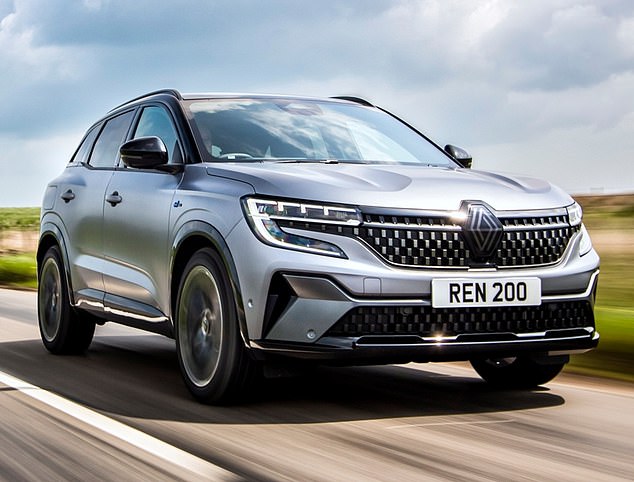
Hybrid reimagined: The Austral E-Tech can operate in many driving modes
So the Austral can drive seamlessly between: all-electric; dynamic hybrid (engine and electric motor working together); E-drive (electric motor moving the wheels and the petrol engine charging the battery); petrol engine only drive and/or charging the battery; and regenerating (where the wheels charge the battery).
There are three trim levels. Prices are from £34,695 for the entry level Techno trim with 19-inch wheels and eight-speaker stereo. In between is Techno Esprit.
I drove the top-range Iconic Esprit Alpine full hybrid 200p model riding on 20 -inch Daytona alloy wheels, priced at £39,495 with a panoramic glass roof, wireless phone charging, Harman Kardon stereo and ‘4Control’ four-wheel rear-axle steering. This allows the Austral to turn on a sixpence.
It accelerates from rest to 62 mph in 8.4 seconds up to 108 mph. Claimed economy is 57.7 mpg with lowish CO2 emissions of 110g/m.
Love it or loathe it, a built-in ‘eco nanny’, monitors your driving and gives you coaching tips to drive more efficiently and cheaply — as well as helping the environment.
Officially it’s called an eco score. It even gives you a percentage score by rating your acceleration, deceleration and anticipation, and tells you how many miles you have driven in pure EV mode. But it might also irritate you and drive you slowly mad.
Renault reckons that in urban driving the car can drive on zero-emissions electric mode alone for up to 80 per cent of the time.
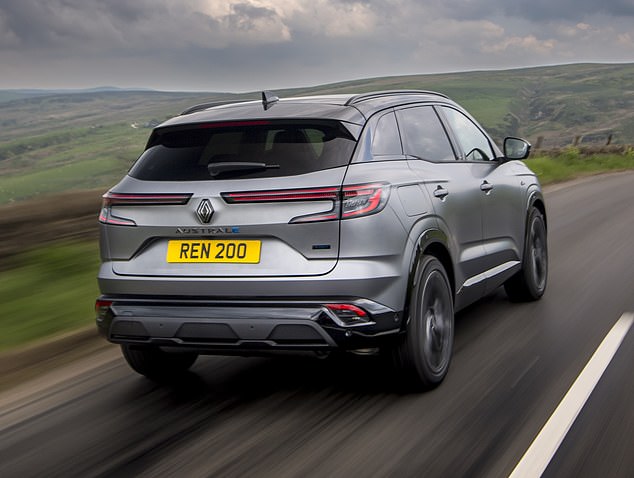
It accelerates from rest to 62 mph in 8.4 seconds up to 108 mph
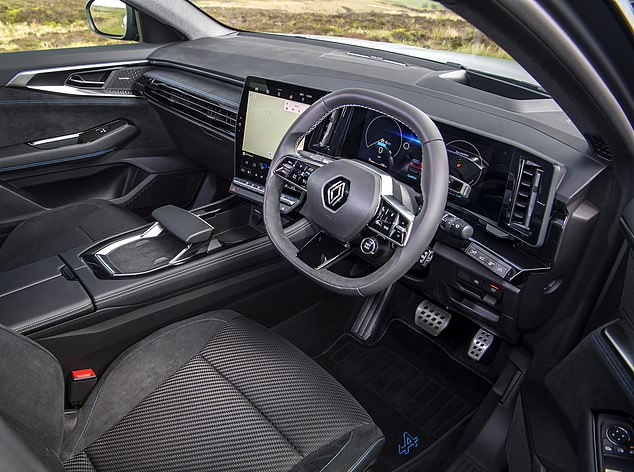
Inside, an industrial sized handle up front allows the centre console hand-rest to slide back and forth
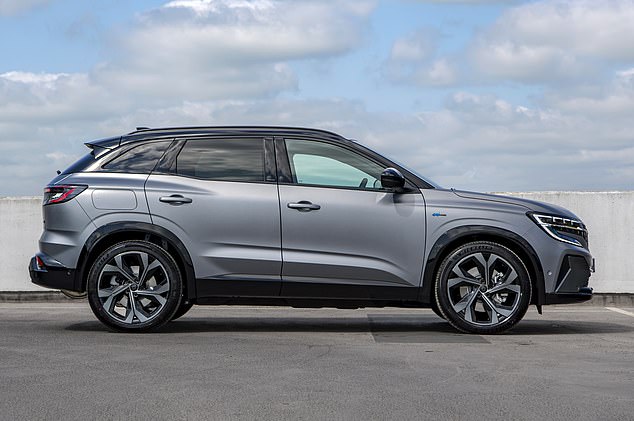
Renault reckons that in urban driving the car can drive on zero-emissions electric mode alone for up to 80 per cent of the time
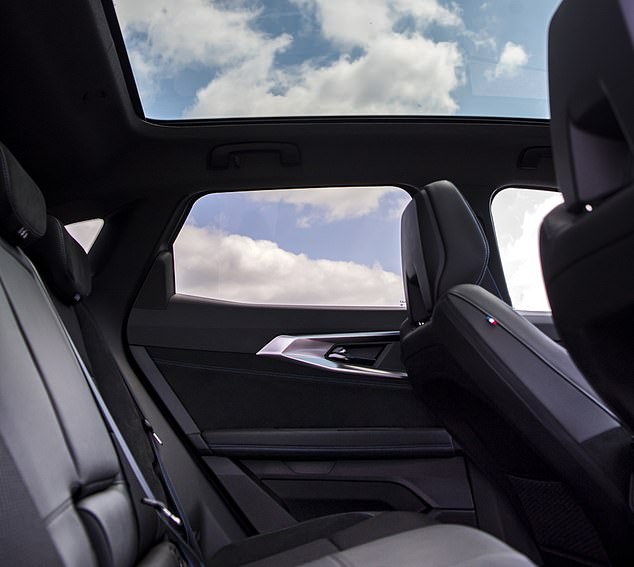
The three rear bench seats – also 60:40 split rear folding – can also slide back and forth to increase leg-room at the cost of space in the boot
Inside, an industrial sized handle up front allows the centre console hand-rest to slide back and forth, and the three rear bench seats – also 60:40 split rear folding – can also slide back and forth to increase leg-room at the cost of space in the boot.
The main driving modes are colour co-ordinated – with the dashboard and surrounding trim lines changing shade accordingly. So ‘comfort’ – a surprisingly good default setting – is blue; ‘eco’ is green; and ‘sport’ a racier red to accompany the car tensing up its muscles for a sportier ride. There’s also normal, and a bespoke set-up option called ‘perso’.
Overall it’s a well-stocked package including: flush-roof bars; LED lights; rear tinted windows; an air purifier; electric adjustable and heated front driver and passenger seats with lumbar support.
The relatively large 9.3 inch head-up display – in addition to the 12.3-inch driver information display and 12-inch multi-media screen – is a really handy and practical addition.
There are up to 30 advanced driver assistance systems including: front and rear active emergency brake assist; autonomous level 2 adaptive cruise control with speed limiter, lane centering, and ‘hands-off’ detection; blind spot and lane-departure warning.
Price key barrier to buying electric car
More than six in ten (62 per cent) customers say price is the key barrier to buying an electric car, a poll by Britain’s car dealers has revealed.
But four in ten (42 per cent) would buy one because of lower running costs, with more than a third (36 per cent) swayed by environmental benefits, says the consumer attitudes report by the National Franchised Dealers Association (NFDA).
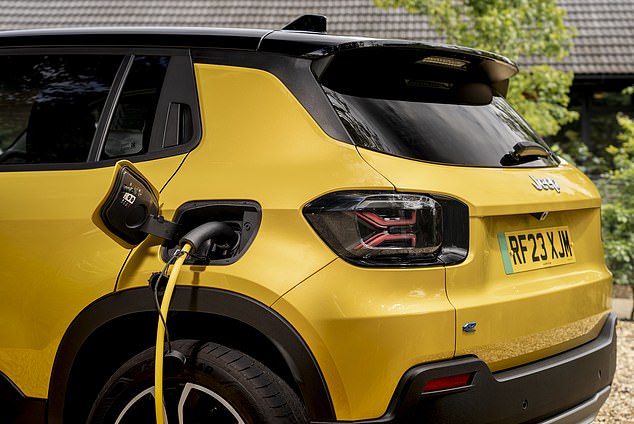
Cheaper: Four in ten would buy an electric car because of lower running costs
Lack of interest was significantly higher for older motorists, while seven in ten 18 to 24-year-olds are interested in buying one.
The report also showed a quarter (26 per cent) of respondents are driving less to beat the cost of living crisis. It noted: ‘We are at an EV tipping point where price and the environment are balancing each other in the consumer’s mind.’
NFDA chief executive Sue Robinson said the report provides ‘a unique insight into consumer behaviour and industry as the car evolves from internal combustion engine to the electric vehicle’.
Failing to park properly is costly
British motorists could be liable for up to £18 million in penalty charge notices for failing to fit their cars inside designated parking bays, according to research by Citroën UK.
A total of 137,000 fines were issued to motorists for failing to park fully within the lines of parking bays since 2019, according to Freedom of Information (FOI) requests issued to the local authorities in the ten largest cities in the country, including all 32 boroughs in London.
Some links in this article may be affiliate links. If you click on them we may earn a small commission. That helps us fund This Is Money, and keep it free to use. We do not write articles to promote products. We do not allow any commercial relationship to affect our editorial independence.



